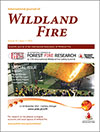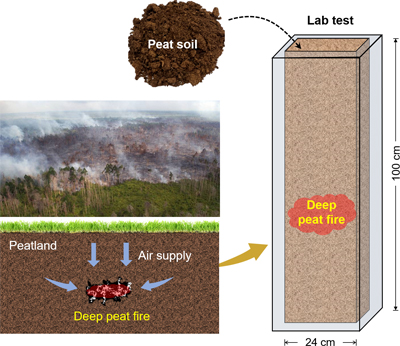
International Journal of Wildland Fire
Volume 32 Number 1 2023
Special IssueIX International Conference on Forest Fire Research and 17th International Wildland Fire Safety Summit (Part 1)
WF23003IX International Conference on Forest Fire Research and 17th International Wildland Fire Safety Summit: introduction to special issue (Part 1)
Here we introduce Part 1 of a special issue series arising from the IX International Conference on Forest Fire Research, held 14–18 November 2022, Coimbra, Portugal. This issue comprises eight papers covering a wide variety of topics. All papers in the issue are published Open Access.
WF23003 Abstract | WF23003 Full Text | WF23003PDF (695 KB) Open Access Article
WF22103Future expansion, seasonal lengthening and intensification of fire activity under climate change in southeastern France
 , Julien Ruffault
, Julien Ruffault  , Thomas Opitz, Hélène Fargeon, Renaud Barbero, Jorge Castel-Clavera
, Thomas Opitz, Hélène Fargeon, Renaud Barbero, Jorge Castel-Clavera  , Nicolas Martin-StPaul, Eric Rigolot and Jean-Luc Dupuy
, Nicolas Martin-StPaul, Eric Rigolot and Jean-Luc Dupuy
Projections of fire activity in southeastern France show that very large increases in fire metrics arise mostly from an intensification in the already fire-prone region during the core of the current fire season and only to a lower degree from an expansion of the fire-prone region and lengthening of the season.
WF22103 Abstract | WF22103 Full Text | WF22103PDF (1.8 MB) | WF22103Supplementary Material (1.6 MB) Open Access Article
WF22086Disentangling the factors of spatio-temporal patterns of wildfire activity in south-eastern France
 , François Pimont
, François Pimont  , Thomas Opitz, Julien Ruffault
, Thomas Opitz, Julien Ruffault  , Miguel Rivière and Jean-Luc Dupuy
, Miguel Rivière and Jean-Luc Dupuy
We leveraged Bayesian spatio-temporal modelling to disentangle the contributions of climatic and non-climatic drivers for fire activity in Mediterranean France. We showed that recent fire-weather increase caused the increase of fire probability in the west; but in the east, it was over-compensated by a reduction of escaped-fire probability.
WF22086 Abstract | WF22086 Full Text | WF22086PDF (2.9 MB) | WF22086Supplementary Material (2 MB) Open Access Article
Temperature perturbations resulting from solar heating of Earth’s surface can induce buoyancy-driven wind turbulence. Using experimental numerical simulations, this work investigates how atmospheric wind turbulence, under different atmospheric conditions, can change the energy transfer within the fire area and subsequently impact fire behaviour.
WF22101 Abstract | WF22101 Full Text | WF22101PDF (4.2 MB) Open Access Article
WF22100Atmospheric turbulent structures and fire sweeps during shrub fires and implications for flaming zone behaviour
 , Andres Valencia, Benjamin Schumacher
, Andres Valencia, Benjamin Schumacher  , Jessica Kerr, Tara Strand, Grant Pearce
, Jessica Kerr, Tara Strand, Grant Pearce  and Peyman Zawar-Reza
and Peyman Zawar-Reza
Multi-modal observations of fire behaviour and overlying atmospheric turbulence were carried out for four wind-driven gorse bush experimental fires. Novel image velocimetry analysis outlined the dynamics and scales of motion of fire sweeps in relation to overlying atmospheric coherent turbulent structures. Results are useful for evaluating coupled fire–atmosphere model simulations.
WF22100 Abstract | WF22100 Full Text | WF22100PDF (5.5 MB) | WF22100Corrigendum (5.5 MB) | WF22100Supplementary Material (164.5 MB) Open Access Article
WF22079Comparing two methods to measure oxidative pyrolysis gases in a wind tunnel and in prescribed burns
 , Timothy J. Johnson
, Timothy J. Johnson  , Tanya L. Myers
, Tanya L. Myers  , Wei Min Hao
, Wei Min Hao  , Stephen Baker, Javier Palarea-Albaladejo
, Stephen Baker, Javier Palarea-Albaladejo  , Nicole K. Scharko, Ashley M. Bradley
, Nicole K. Scharko, Ashley M. Bradley  , Catherine A. Banach
, Catherine A. Banach  and Russell G. Tonkyn
and Russell G. Tonkyn 
Oxidative pyrolysis gases were measured in a wind tunnel and small prescribed burns using two analytical methods. Gas composition measured by FTIR spectroscopy differed between wind tunnel and field fires. The relative amount of the primary fuel gases (CO, CH4) was not significantly affected by fire location.
WF22079 Abstract | WF22079 Full Text | WF22079PDF (2.7 MB) Open Access Article
WF22093Comparing particulate morphology generated from human-made cellulosic fuels to natural vegetative fuels
In wildland–urban interface fires, particulates from combustion of natural vegetative and human-made fuels may have deleterious effects on the environment. Particulate samples were taken during both flaming combustion and smouldering combustion states. The morphology of the generated particulates is greatly influenced by the state of combustion for both fuels.
WF22093 Abstract | WF22093 Full Text | WF22093PDF (2.8 MB) Open Access Article

Smouldering fire in peatland is one of the largest wildfire phenomena on Earth that can burn slowly deep underground without flame. Laboratory experiments on tall peat soil samples revealed burning, propagation and emission physics of deep smouldering wildfires in peatland.
WF22143 Abstract | WF22143 Full Text | WF22143PDF (4.2 MB) | WF22143Supplementary Material (38.4 MB) Open Access Article
WF22091Burnt wood management enhances soil multifunctionality at the medium term after a large wildfire in north-west Spain
Post-fire treatment consisting of leaving burnt logs and felled branches in close contact with the forest floor promotes the ability of the soil to sustain high values of multiple functions simultaneously in the medium term after wildfire, as compared to straw mulching application.
WF22091 Abstract | WF22091 Full Text | WF22091PDF (2.2 MB) Open Access Article




